Samsung NP355V4C + Linux review
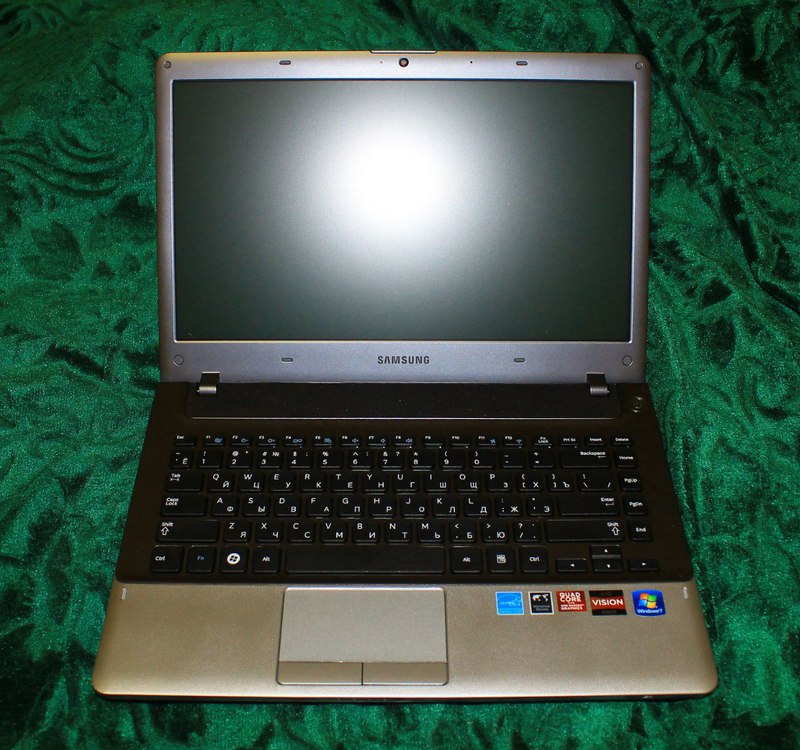
Background
Hello Hawkers. In this article, I will tell you about the Samsung NP355V4C laptop and some details about how Linux (ArchLinux distribution) works on it.
Why did I choose this particular laptop? Just a week ago, I used the Samsung N150 Plus, it's such a small 10-inch netbook on an Atom processor. He served me faithfully for 2 years, but his iron is outdated, to put it mildly. The thing is that I bought that netbook back when I was at school. I had enough for almost all tasks regarding the Internet and picking in Linux. However, now at the institute the slowness and limitedness of the netbook (no virtualization) is unbearable. Sometimes it was even more convenient to remotely use a home computer than to do similar actions on the netbook itself. Additionally, the battery has already worn out, and the operating time was about 4 hours.
Then I started choosing a faster laptop. I have an AMD Athlon II X3 440 processor on my computer, and I love AMD processors. I needed a laptop, not small, but not large, since I often needed to carry it to college. To draw the game and the overall speed was at its best. I did not need much battery life - at the institute I just had four hours of worn-out netbook. Yes, and if there are sockets there :-).
Under the habrakat there is a lot of text from the console and pictures.
The choice fell on the NP355V4C already familiar to me from Samsung. He had my favorite AMD processor of the new model - A10-4600M built on the new APU Trinity core. It has 4 cores, but judging by the information on the network, for every 2 cores it has a common block of calculations for floating point numbers. Perhaps this was done to reduce the cost of the processor. And as we all remember, the GPU performs the best calculations of floating-point numbers. And the A10 is just equipped with AMD Radeon HD 7660G as an integrated video. That is, this solution allows the browser to get much more performance when accelerating through the GPU than it would when working with an integrated video chip from Intel. In addition, this laptop has a discrete graphics card AMD Radeon HD 7670M, it has a slightly faster GPU and 2 gigabytes of dedicated video memory. And for example, in Windows, you can use Dual Graphics technology and get an increase of up to 50% in performance. True, there are subsidence. However, in some games this bundle bypasses the Nvidia 640M. The size of the laptop is 14 inches, i.e. it's not those small 10-11 as on a netbook, but not 15-17 as on heavy models. Yes, and drivers for Linux seem to be rapidly improving.
As a result, we get the best option: low price. The latest generation fast processor, 2 graphics cards and a small size.
Iron.

The basic information can be found in the Yandex Market.
But at the request of the comments I will describe here my option.
- Processor + integrated video chip: APU AMD A10-4600M + AMD Radeon HD 7660G with a frequency of 2.3Ghz (3.2 Ghz Turbo)
- Memory: 6 GB (2 brackets: one on 4 GB, the other on 2 GB. Maximum 8 GB. Frequency 1600 MHz)
- Internal storage: HDD 750 Gb
- Discrete graphics card: AMD Radeon HD 7670M 2048 MB GDDR3 (can be paired with integrated chips for Windows in games with DirectX 10 and 11)
- Wifi: Atheros AR9485 802.11n
- Bluetooth: Atheros (unknown model) version 4.0
- Camera: 1.3 MP. For video calls just right. Better than on my netbook, but there are still noises.
- Screen: 14 inches, 1366x768, matte anti-glare
- Weight: 2.25 kg
- Card Reader: Realtek RTS5129 for SD Cards
- Battery: 4400mAh claimed 4 hours. Without energy saving under Linux, it pulls 1-2 hours of Internet access on a disc.
- Connectors: for headphones, microphone, usb 2.0, 2x USB 3.0, Ethernet 1Gbit, HDMI, VGA
- There is a DVD drive, which can then be replaced with an SSD.
However, not in vain in the title I wrote about Linux. Below I will present the output of information about a laptop from under ArchLinux, so it will be easier to find out, for example, which Wifi module works in it, and not just 802.11n, by the way it pulls at 150 Mbps. Let's get started.
cat / proc / cpuinfo
[root @ bupyc-notebook bupyc] # cat / proc / cpuinfo
processor: 0
vendor_id: AuthenticAMD
cpu family: 21
model: 16
model name: AMD A10-4600M APU with Radeon (tm) HD Graphics
stepping: 1
microcode: 0x6001119
cpu MHz : 2300.000
cache size: 2048 KB
physical id: 0
siblings: 4
core id: 0
cpu cores: 2
apicid: 16
initial apicid: 0
fpu: yes
fpu_exception: yes
cpuid level: 13
wp: yes
flags: fpu vme de pse tsc msr pae mce cx8 apic sep mtrr pge mca cmov pat pse36 clflush mmx fxsr sse sse2 ht syscall nx mmxext fxsr_opt pdpe1gb rdtscp lm constant_tsc rep_good nopl nonstop_tsc extd_apicid aperfmperf pni pclmulqdq monitor ssse3 fma cx16 sse4_1 sse4_2 popcnt aes xsave avx f16c lahf_lm cmp_legacy svm extapic cr8_legacy abm sse4a misalignsse 3dnowprefetch osvw ibs xop skinit wdt lwp fma4 tce nodeid_msr tbm topoext perfctr_core arat cpb hw_pstate npt lbrv svm_lock nrip_save tsc_scale vmcb_clean flushbyasid decodeassists pausefilter pfthreshold bmi1
bogomips: 4593.94
TLB size: 1536 4K pages
clflush size: 64
cache_alignment : 64
address sizes: 48 bits physical, 48 bits virtual
power management: ts ttp tm 100mhzsteps hwpstate cpb eff_freq_ro
processor: 1
vendor_id: AuthenticAMD
cpu family: 21
model: 16
model name: AMD A10-4600M APU with Radeon (tm) HD Graphics
stepping: 1
microcode: 0x6001119
cpu MHz: 2300.000
cache size: 2048 KB
physical id: 0
siblings: 4
core id: 1
cpu cores: 2
apicid: 17
initial apicid: 1
fpu: yes
fpu_exception: yes
cpuid level: 13
wp: yes
flags: fpu vme de pse tsc msr pae mce cx8 apic sep mtrr pge mca cmov pat pse36 clflush mmx fxsr sse sse2 ht syscall nx mmxext fxsr_opt pdpe1gb rdtscp lm constant_tsc rep_good nopl nonstop_tsc extd_apicid aperfmperf pni pclmulqdq monitor ssse3 fma cx16 sse4_1 sse4_2 popcnt aes xsave avx f16c lahf_lm cmp_legacy svm extapic cr8_legacy abm sse4a misalignsse 3dnowprefetch osvw ibs xop skinit wdt lwp fma4 tce nodeid_msr tbm topoext perfctr_core arat cpb hw_pstate npt lbrv svm_lock nrip_save tsc_scale vmcb_clean flushbyasid decodeassists pausefilter pfthreshold bmi1
bogomips: 4593.94
TLB size: 1536 4K pages
clflush size: 64
cache_alignment : 64
address sizes: 48 bits physical, 48 bits virtual
power management: ts ttp tm 100mhzsteps hwpstate cpb eff_freq_ro
processor: 2
vendor_id: AuthenticAMD
cpu family: 21
model: 16
model name: AMD A10-4600M APU with Radeon (tm) HD Graphics
stepping: 1
microcode: 0x6001119
cpu MHz: 2300.000
cache size: 2048 KB
physical id: 0
siblings: 4
core id: 2
cpu cores: 2
apicid: 18
initial apicid: 2
fpu: yes
fpu_exception: yes
cpuid level: 13
wp: yes
flags: fpu vme de pse tsc msr pae mce cx8 apic sep mtrr pge mca cmov pat pse36 clflush mmx fxsr sse sse2 ht syscall nx mmxext fxsr_opt pdpe1gb rdtscp lm constant_tsc rep_good nopl nonstop_tsc extd_apicid aperfmperf pni pclmulqdq monitor ssse3 fma cx16 sse4_1 sse4_2 popcnt aes xsave avx f16c lahf_lm cmp_legacy svm extapic cr8_legacy abm sse4a misalignsse 3dnowprefetch osvw ibs xop skinit wdt lwp fma4 tce nodeid_msr tbm topoext perfctr_core arat cpb hw_pstate npt lbrv svm_lock nrip_save tsc_scale vmcb_clean flushbyasid decodeassists pausefilter pfthreshold bmi1
bogomips: 4593.94
TLB size: 1536 4K pages
clflush size: 64
cache_alignment : 64
address sizes: 48 bits physical, 48 bits virtual
power management: ts ttp tm 100mhzsteps hwpstate cpb eff_freq_ro
processor: 3
vendor_id: AuthenticAMD
cpu family: 21
model: 16
model name: AMD A10-4600M APU with Radeon (tm) HD Graphics
stepping: 1
microcode: 0x6001119
cpu MHz: 2300.000
cache size: 2048 KB
physical id: 0
siblings: 4
core id: 3
cpu cores: 2
apicid: 19
initial apicid: 3
fpu: yes
fpu_exception: yes
cpuid level: 13
wp: yes
flags: fpu vme de pse tsc msr pae mce cx8 apic sep mtrr pge mca cmov pat pse36 clflush mmx fxsr sse sse2 ht syscall nx mmxext fxsr_opt pdpe1gb rdtscp lm constant_tsc rep_good nopl nonstop_tsc extd_apicid aperfmperf pni pclmulqdq monitor ssse3 fma cx16 sse4_1 sse4_2 popcnt aes xsave avx f16c lahf_lm cmp_legacy svm extapic cr8_legacy abm sse4a misalignsse 3dnowprefetch osvw ibs xop skinit wdt lwp fma4 tce nodeid_msr tbm topoext perfctr_core arat cpb hw_pstate npt lbrv svm_lock nrip_save tsc_scale vmcb_clean flushbyasid decodeassists pausefilter pfthreshold bmi1
bogomips: 4593.94
TLB size: 1536 4K pages
clflush size: 64
cache_alignment : 64
address sizes: 48 bits physical, 48 bits virtual
power management: ts ttp tm 100mhzsteps hwpstate cpb eff_freq_ro
[root @ bupyc-notebook bupyc] # cat / proc / cpuinfo
processor: 0
vendor_id: AuthenticAMD
cpu family: 21
model: 16
model name: AMD A10-4600M APU with Radeon (tm) HD Graphics
stepping: 1
microcode: 0x6001119
cpu MHz : 2300.000
cache size: 2048 KB
physical id: 0
siblings: 4
core id: 0
cpu cores: 2
apicid: 16
initial apicid: 0
fpu: yes
fpu_exception: yes
cpuid level: 13
wp: yes
flags: fpu vme de pse tsc msr pae mce cx8 apic sep mtrr pge mca cmov pat pse36 clflush mmx fxsr sse sse2 ht syscall nx mmxext fxsr_opt pdpe1gb rdtscp lm constant_tsc rep_good nopl nonstop_tsc extd_apicid aperfmperf pni pclmulqdq monitor ssse3 fma cx16 sse4_1 sse4_2 popcnt aes xsave avx f16c lahf_lm cmp_legacy svm extapic cr8_legacy abm sse4a misalignsse 3dnowprefetch osvw ibs xop skinit wdt lwp fma4 tce nodeid_msr tbm topoext perfctr_core arat cpb hw_pstate npt lbrv svm_lock nrip_save tsc_scale vmcb_clean flushbyasid decodeassists pausefilter pfthreshold bmi1
bogomips: 4593.94
TLB size: 1536 4K pages
clflush size: 64
cache_alignment : 64
address sizes: 48 bits physical, 48 bits virtual
power management: ts ttp tm 100mhzsteps hwpstate cpb eff_freq_ro
processor: 1
vendor_id: AuthenticAMD
cpu family: 21
model: 16
model name: AMD A10-4600M APU with Radeon (tm) HD Graphics
stepping: 1
microcode: 0x6001119
cpu MHz: 2300.000
cache size: 2048 KB
physical id: 0
siblings: 4
core id: 1
cpu cores: 2
apicid: 17
initial apicid: 1
fpu: yes
fpu_exception: yes
cpuid level: 13
wp: yes
flags: fpu vme de pse tsc msr pae mce cx8 apic sep mtrr pge mca cmov pat pse36 clflush mmx fxsr sse sse2 ht syscall nx mmxext fxsr_opt pdpe1gb rdtscp lm constant_tsc rep_good nopl nonstop_tsc extd_apicid aperfmperf pni pclmulqdq monitor ssse3 fma cx16 sse4_1 sse4_2 popcnt aes xsave avx f16c lahf_lm cmp_legacy svm extapic cr8_legacy abm sse4a misalignsse 3dnowprefetch osvw ibs xop skinit wdt lwp fma4 tce nodeid_msr tbm topoext perfctr_core arat cpb hw_pstate npt lbrv svm_lock nrip_save tsc_scale vmcb_clean flushbyasid decodeassists pausefilter pfthreshold bmi1
bogomips: 4593.94
TLB size: 1536 4K pages
clflush size: 64
cache_alignment : 64
address sizes: 48 bits physical, 48 bits virtual
power management: ts ttp tm 100mhzsteps hwpstate cpb eff_freq_ro
processor: 2
vendor_id: AuthenticAMD
cpu family: 21
model: 16
model name: AMD A10-4600M APU with Radeon (tm) HD Graphics
stepping: 1
microcode: 0x6001119
cpu MHz: 2300.000
cache size: 2048 KB
physical id: 0
siblings: 4
core id: 2
cpu cores: 2
apicid: 18
initial apicid: 2
fpu: yes
fpu_exception: yes
cpuid level: 13
wp: yes
flags: fpu vme de pse tsc msr pae mce cx8 apic sep mtrr pge mca cmov pat pse36 clflush mmx fxsr sse sse2 ht syscall nx mmxext fxsr_opt pdpe1gb rdtscp lm constant_tsc rep_good nopl nonstop_tsc extd_apicid aperfmperf pni pclmulqdq monitor ssse3 fma cx16 sse4_1 sse4_2 popcnt aes xsave avx f16c lahf_lm cmp_legacy svm extapic cr8_legacy abm sse4a misalignsse 3dnowprefetch osvw ibs xop skinit wdt lwp fma4 tce nodeid_msr tbm topoext perfctr_core arat cpb hw_pstate npt lbrv svm_lock nrip_save tsc_scale vmcb_clean flushbyasid decodeassists pausefilter pfthreshold bmi1
bogomips: 4593.94
TLB size: 1536 4K pages
clflush size: 64
cache_alignment : 64
address sizes: 48 bits physical, 48 bits virtual
power management: ts ttp tm 100mhzsteps hwpstate cpb eff_freq_ro
processor: 3
vendor_id: AuthenticAMD
cpu family: 21
model: 16
model name: AMD A10-4600M APU with Radeon (tm) HD Graphics
stepping: 1
microcode: 0x6001119
cpu MHz: 2300.000
cache size: 2048 KB
physical id: 0
siblings: 4
core id: 3
cpu cores: 2
apicid: 19
initial apicid: 3
fpu: yes
fpu_exception: yes
cpuid level: 13
wp: yes
flags: fpu vme de pse tsc msr pae mce cx8 apic sep mtrr pge mca cmov pat pse36 clflush mmx fxsr sse sse2 ht syscall nx mmxext fxsr_opt pdpe1gb rdtscp lm constant_tsc rep_good nopl nonstop_tsc extd_apicid aperfmperf pni pclmulqdq monitor ssse3 fma cx16 sse4_1 sse4_2 popcnt aes xsave avx f16c lahf_lm cmp_legacy svm extapic cr8_legacy abm sse4a misalignsse 3dnowprefetch osvw ibs xop skinit wdt lwp fma4 tce nodeid_msr tbm topoext perfctr_core arat cpb hw_pstate npt lbrv svm_lock nrip_save tsc_scale vmcb_clean flushbyasid decodeassists pausefilter pfthreshold bmi1
bogomips: 4593.94
TLB size: 1536 4K pages
clflush size: 64
cache_alignment : 64
address sizes: 48 bits physical, 48 bits virtual
power management: ts ttp tm 100mhzsteps hwpstate cpb eff_freq_ro
processor: 0
vendor_id: AuthenticAMD
cpu family: 21
model: 16
model name: AMD A10-4600M APU with Radeon (tm) HD Graphics
stepping: 1
microcode: 0x6001119
cpu MHz : 2300.000
cache size: 2048 KB
physical id: 0
siblings: 4
core id: 0
cpu cores: 2
apicid: 16
initial apicid: 0
fpu: yes
fpu_exception: yes
cpuid level: 13
wp: yes
flags: fpu vme de pse tsc msr pae mce cx8 apic sep mtrr pge mca cmov pat pse36 clflush mmx fxsr sse sse2 ht syscall nx mmxext fxsr_opt pdpe1gb rdtscp lm constant_tsc rep_good nopl nonstop_tsc extd_apicid aperfmperf pni pclmulqdq monitor ssse3 fma cx16 sse4_1 sse4_2 popcnt aes xsave avx f16c lahf_lm cmp_legacy svm extapic cr8_legacy abm sse4a misalignsse 3dnowprefetch osvw ibs xop skinit wdt lwp fma4 tce nodeid_msr tbm topoext perfctr_core arat cpb hw_pstate npt lbrv svm_lock nrip_save tsc_scale vmcb_clean flushbyasid decodeassists pausefilter pfthreshold bmi1
bogomips: 4593.94
TLB size: 1536 4K pages
clflush size: 64
cache_alignment : 64
address sizes: 48 bits physical, 48 bits virtual
power management: ts ttp tm 100mhzsteps hwpstate cpb eff_freq_ro
processor: 1
vendor_id: AuthenticAMD
cpu family: 21
model: 16
model name: AMD A10-4600M APU with Radeon (tm) HD Graphics
stepping: 1
microcode: 0x6001119
cpu MHz: 2300.000
cache size: 2048 KB
physical id: 0
siblings: 4
core id: 1
cpu cores: 2
apicid: 17
initial apicid: 1
fpu: yes
fpu_exception: yes
cpuid level: 13
wp: yes
flags: fpu vme de pse tsc msr pae mce cx8 apic sep mtrr pge mca cmov pat pse36 clflush mmx fxsr sse sse2 ht syscall nx mmxext fxsr_opt pdpe1gb rdtscp lm constant_tsc rep_good nopl nonstop_tsc extd_apicid aperfmperf pni pclmulqdq monitor ssse3 fma cx16 sse4_1 sse4_2 popcnt aes xsave avx f16c lahf_lm cmp_legacy svm extapic cr8_legacy abm sse4a misalignsse 3dnowprefetch osvw ibs xop skinit wdt lwp fma4 tce nodeid_msr tbm topoext perfctr_core arat cpb hw_pstate npt lbrv svm_lock nrip_save tsc_scale vmcb_clean flushbyasid decodeassists pausefilter pfthreshold bmi1
bogomips: 4593.94
TLB size: 1536 4K pages
clflush size: 64
cache_alignment : 64
address sizes: 48 bits physical, 48 bits virtual
power management: ts ttp tm 100mhzsteps hwpstate cpb eff_freq_ro
processor: 2
vendor_id: AuthenticAMD
cpu family: 21
model: 16
model name: AMD A10-4600M APU with Radeon (tm) HD Graphics
stepping: 1
microcode: 0x6001119
cpu MHz: 2300.000
cache size: 2048 KB
physical id: 0
siblings: 4
core id: 2
cpu cores: 2
apicid: 18
initial apicid: 2
fpu: yes
fpu_exception: yes
cpuid level: 13
wp: yes
flags: fpu vme de pse tsc msr pae mce cx8 apic sep mtrr pge mca cmov pat pse36 clflush mmx fxsr sse sse2 ht syscall nx mmxext fxsr_opt pdpe1gb rdtscp lm constant_tsc rep_good nopl nonstop_tsc extd_apicid aperfmperf pni pclmulqdq monitor ssse3 fma cx16 sse4_1 sse4_2 popcnt aes xsave avx f16c lahf_lm cmp_legacy svm extapic cr8_legacy abm sse4a misalignsse 3dnowprefetch osvw ibs xop skinit wdt lwp fma4 tce nodeid_msr tbm topoext perfctr_core arat cpb hw_pstate npt lbrv svm_lock nrip_save tsc_scale vmcb_clean flushbyasid decodeassists pausefilter pfthreshold bmi1
bogomips: 4593.94
TLB size: 1536 4K pages
clflush size: 64
cache_alignment : 64
address sizes: 48 bits physical, 48 bits virtual
power management: ts ttp tm 100mhzsteps hwpstate cpb eff_freq_ro
processor: 3
vendor_id: AuthenticAMD
cpu family: 21
model: 16
model name: AMD A10-4600M APU with Radeon (tm) HD Graphics
stepping: 1
microcode: 0x6001119
cpu MHz: 2300.000
cache size: 2048 KB
physical id: 0
siblings: 4
core id: 3
cpu cores: 2
apicid: 19
initial apicid: 3
fpu: yes
fpu_exception: yes
cpuid level: 13
wp: yes
flags: fpu vme de pse tsc msr pae mce cx8 apic sep mtrr pge mca cmov pat pse36 clflush mmx fxsr sse sse2 ht syscall nx mmxext fxsr_opt pdpe1gb rdtscp lm constant_tsc rep_good nopl nonstop_tsc extd_apicid aperfmperf pni pclmulqdq monitor ssse3 fma cx16 sse4_1 sse4_2 popcnt aes xsave avx f16c lahf_lm cmp_legacy svm extapic cr8_legacy abm sse4a misalignsse 3dnowprefetch osvw ibs xop skinit wdt lwp fma4 tce nodeid_msr tbm topoext perfctr_core arat cpb hw_pstate npt lbrv svm_lock nrip_save tsc_scale vmcb_clean flushbyasid decodeassists pausefilter pfthreshold bmi1
bogomips: 4593.94
TLB size: 1536 4K pages
clflush size: 64
cache_alignment : 64
address sizes: 48 bits physical, 48 bits virtual
power management: ts ttp tm 100mhzsteps hwpstate cpb eff_freq_ro
[root @ bupyc-notebook bupyc] # cat / proc / cpuinfo
processor: 0
vendor_id: AuthenticAMD
cpu family: 21
model: 16
model name: AMD A10-4600M APU with Radeon (tm) HD Graphics
stepping: 1
microcode: 0x6001119
cpu MHz : 2300.000
cache size: 2048 KB
physical id: 0
siblings: 4
core id: 0
cpu cores: 2
apicid: 16
initial apicid: 0
fpu: yes
fpu_exception: yes
cpuid level: 13
wp: yes
flags: fpu vme de pse tsc msr pae mce cx8 apic sep mtrr pge mca cmov pat pse36 clflush mmx fxsr sse sse2 ht syscall nx mmxext fxsr_opt pdpe1gb rdtscp lm constant_tsc rep_good nopl nonstop_tsc extd_apicid aperfmperf pni pclmulqdq monitor ssse3 fma cx16 sse4_1 sse4_2 popcnt aes xsave avx f16c lahf_lm cmp_legacy svm extapic cr8_legacy abm sse4a misalignsse 3dnowprefetch osvw ibs xop skinit wdt lwp fma4 tce nodeid_msr tbm topoext perfctr_core arat cpb hw_pstate npt lbrv svm_lock nrip_save tsc_scale vmcb_clean flushbyasid decodeassists pausefilter pfthreshold bmi1
bogomips: 4593.94
TLB size: 1536 4K pages
clflush size: 64
cache_alignment : 64
address sizes: 48 bits physical, 48 bits virtual
power management: ts ttp tm 100mhzsteps hwpstate cpb eff_freq_ro
processor: 1
vendor_id: AuthenticAMD
cpu family: 21
model: 16
model name: AMD A10-4600M APU with Radeon (tm) HD Graphics
stepping: 1
microcode: 0x6001119
cpu MHz: 2300.000
cache size: 2048 KB
physical id: 0
siblings: 4
core id: 1
cpu cores: 2
apicid: 17
initial apicid: 1
fpu: yes
fpu_exception: yes
cpuid level: 13
wp: yes
flags: fpu vme de pse tsc msr pae mce cx8 apic sep mtrr pge mca cmov pat pse36 clflush mmx fxsr sse sse2 ht syscall nx mmxext fxsr_opt pdpe1gb rdtscp lm constant_tsc rep_good nopl nonstop_tsc extd_apicid aperfmperf pni pclmulqdq monitor ssse3 fma cx16 sse4_1 sse4_2 popcnt aes xsave avx f16c lahf_lm cmp_legacy svm extapic cr8_legacy abm sse4a misalignsse 3dnowprefetch osvw ibs xop skinit wdt lwp fma4 tce nodeid_msr tbm topoext perfctr_core arat cpb hw_pstate npt lbrv svm_lock nrip_save tsc_scale vmcb_clean flushbyasid decodeassists pausefilter pfthreshold bmi1
bogomips: 4593.94
TLB size: 1536 4K pages
clflush size: 64
cache_alignment : 64
address sizes: 48 bits physical, 48 bits virtual
power management: ts ttp tm 100mhzsteps hwpstate cpb eff_freq_ro
processor: 2
vendor_id: AuthenticAMD
cpu family: 21
model: 16
model name: AMD A10-4600M APU with Radeon (tm) HD Graphics
stepping: 1
microcode: 0x6001119
cpu MHz: 2300.000
cache size: 2048 KB
physical id: 0
siblings: 4
core id: 2
cpu cores: 2
apicid: 18
initial apicid: 2
fpu: yes
fpu_exception: yes
cpuid level: 13
wp: yes
flags: fpu vme de pse tsc msr pae mce cx8 apic sep mtrr pge mca cmov pat pse36 clflush mmx fxsr sse sse2 ht syscall nx mmxext fxsr_opt pdpe1gb rdtscp lm constant_tsc rep_good nopl nonstop_tsc extd_apicid aperfmperf pni pclmulqdq monitor ssse3 fma cx16 sse4_1 sse4_2 popcnt aes xsave avx f16c lahf_lm cmp_legacy svm extapic cr8_legacy abm sse4a misalignsse 3dnowprefetch osvw ibs xop skinit wdt lwp fma4 tce nodeid_msr tbm topoext perfctr_core arat cpb hw_pstate npt lbrv svm_lock nrip_save tsc_scale vmcb_clean flushbyasid decodeassists pausefilter pfthreshold bmi1
bogomips: 4593.94
TLB size: 1536 4K pages
clflush size: 64
cache_alignment : 64
address sizes: 48 bits physical, 48 bits virtual
power management: ts ttp tm 100mhzsteps hwpstate cpb eff_freq_ro
processor: 3
vendor_id: AuthenticAMD
cpu family: 21
model: 16
model name: AMD A10-4600M APU with Radeon (tm) HD Graphics
stepping: 1
microcode: 0x6001119
cpu MHz: 2300.000
cache size: 2048 KB
physical id: 0
siblings: 4
core id: 3
cpu cores: 2
apicid: 19
initial apicid: 3
fpu: yes
fpu_exception: yes
cpuid level: 13
wp: yes
flags: fpu vme de pse tsc msr pae mce cx8 apic sep mtrr pge mca cmov pat pse36 clflush mmx fxsr sse sse2 ht syscall nx mmxext fxsr_opt pdpe1gb rdtscp lm constant_tsc rep_good nopl nonstop_tsc extd_apicid aperfmperf pni pclmulqdq monitor ssse3 fma cx16 sse4_1 sse4_2 popcnt aes xsave avx f16c lahf_lm cmp_legacy svm extapic cr8_legacy abm sse4a misalignsse 3dnowprefetch osvw ibs xop skinit wdt lwp fma4 tce nodeid_msr tbm topoext perfctr_core arat cpb hw_pstate npt lbrv svm_lock nrip_save tsc_scale vmcb_clean flushbyasid decodeassists pausefilter pfthreshold bmi1
bogomips: 4593.94
TLB size: 1536 4K pages
clflush size: 64
cache_alignment : 64
address sizes: 48 bits physical, 48 bits virtual
power management: ts ttp tm 100mhzsteps hwpstate cpb eff_freq_ro
cat / proc / meminfo
[root @ bupyc-notebook bupyc] # cat / proc / meminfo
MemTotal: 5501136 kB
MemFree: 1089160 kB
Buffers: 44316 kB
Cached: 1744456 kB
SwapCached: 0 kB
Active: 2711496 kB
Inactive: 1254508 kB
Active (anon): 2178344 kB
Inactive (anon): 23404 kB
Active (file): 533152 kB
Inactive (file): 1231104 kB
Unevictable: 0 kB
Mlocked: 0 kB
SwapTotal: 0 kB
SwapFree: 0 kB
Dirty: 4148 kB
Writeback: 0 kB
AnonPages: 2177240 kB
Mapped: 301064 kB
Shmem: 24516 kB
Slab: 96580 kB
SReclaimable: 71224 kB
SUnreclaim: 25356 kB
KernelStack: 2352 kB
PageTables: 34336 kB
NFS_Unstable: 0 kB
Bounce: 0 kB
WritebackTmp: 0 kB
CommitLimit: 2750568 kB
Committed_AS: 3694928 kB
VmallocTotal: 34359738367 kB
VmallocUsed: 343 976 kB
VmallocChunk: 34359392124 kB
HardwareCorrupted: 0 kB
AnonHugePages: 315392 kB
HugePages_Total: 0
HugePages_Free: 0
HugePages_Rsvd: 0
HugePages_Surp: 0
Hugepagesize: 2048 kB
DirectMap4k: 366588 kB
DirectMap2M: 4327424 kB
DirectMap1G: 1048576 kB
MemTotal: 5501136 kB
MemFree: 1089160 kB
Buffers: 44316 kB
Cached: 1744456 kB
SwapCached: 0 kB
Active: 2711496 kB
Inactive: 1254508 kB
Active (anon): 2178344 kB
Inactive (anon): 23404 kB
Active (file): 533152 kB
Inactive (file): 1231104 kB
Unevictable: 0 kB
Mlocked: 0 kB
SwapTotal: 0 kB
SwapFree: 0 kB
Dirty: 4148 kB
Writeback: 0 kB
AnonPages: 2177240 kB
Mapped: 301064 kB
Shmem: 24516 kB
Slab: 96580 kB
SReclaimable: 71224 kB
SUnreclaim: 25356 kB
KernelStack: 2352 kB
PageTables: 34336 kB
NFS_Unstable: 0 kB
Bounce: 0 kB
WritebackTmp: 0 kB
CommitLimit: 2750568 kB
Committed_AS: 3694928 kB
VmallocTotal: 34359738367 kB
VmallocUsed: 343 976 kB
VmallocChunk: 34359392124 kB
HardwareCorrupted: 0 kB
AnonHugePages: 315392 kB
HugePages_Total: 0
HugePages_Free: 0
HugePages_Rsvd: 0
HugePages_Surp: 0
Hugepagesize: 2048 kB
DirectMap4k: 366588 kB
DirectMap2M: 4327424 kB
DirectMap1G: 1048576 kB
Yes, yes, 5501136 Kb is available, the rest is consumed by the integrated video card, even if the disc works.
lspci
[root @ bupyc-notebook bupyc] # lspci
00: 00.0 Host bridge: Advanced Micro Devices [AMD] Family 15h (Models 10h-1fh) Processor Root Complex
00: 01.0 VGA compatible controller: Advanced Micro Devices [AMD] nee ATI Device 9900
00: 01.1 Audio device: Advanced Micro Devices [AMD] nee ATI Trinity HDMI Audio Controller
00: 02.0 PCI bridge: Advanced Micro Devices [AMD] Family 15h (Models 10h-1fh) Processor Root Port
00: 04.0 PCI bridge: Advanced Micro Devices [AMD] Family 15h (Models 10h-1fh) Processor Root Port
00: 05.0 PCI bridge: Advanced Micro Devices [AMD] Family 15h (Models 10h-1fh) Processor Root Port
00: 10.0 USB controller: Advanced Micro Devices [AMD] FCH USB XHCI Controller (rev 03)
00: 11.0 SATA controller: Advanced Micro Devices [AMD] FCH SATA Controller [AHCI mode]
00: 12.0 USB controller: Advanced Micro Devices [AMD] FCH USB OHCI Controller (rev 11)
00: 12.2 USB controller: Advanced Micro Devices [AMD ] FCH USB EHCI Controller (rev 11)
00: 14.0 SMBus: Advanced Micro Devices [AMD] FCH SMBus Controller (rev 14)
00: 14.2 Audio device: Advanced Micro Devices [AMD] FCH Azalia Controller (rev 01)
00: 14.3 ISA bridge: Advanced Micro Devices [AMD] FCH LPC Bridge (rev 11)
00: 14.4 PCI bridge: Advanced Micro Devices [AMD] FCH PCI Bridge (rev 40)
00: 18.0 Host bridge: Advanced Micro Devices [AMD] Family 15h (Models 10h-1fh) Processor Function 0
00: 18.1 Host bridge: Advanced Micro Devices [AMD] Family
15h (Models 10h-1fh) Processor Function 2
00: 18.3 Host bridge: Advanced Micro Devices [AMD] Family 15h (Models 10h
-1fh) Processor Function 4
00: 18.5 Host bridge: Advanced Micro Devices [AMD] Family 15h (Models 10h-1fh) Processor Function 5
01: 00.0 VGA compatible controller: Advanced Micro Devices [AMD] nee ATI Thames XT / GL [Radeon HD 7600M Series]
02: 00.0 Ethernet controller: Realtek Semiconductor Co. , Ltd. RTL8111 / 8168B PCI Express Gigabit Ethernet controller (rev 09)
03: 00.0 Network controller: Atheros Communications Inc. AR9485 Wireless Network Adapter (rev 01)
00: 00.0 Host bridge: Advanced Micro Devices [AMD] Family 15h (Models 10h-1fh) Processor Root Complex
00: 01.0 VGA compatible controller: Advanced Micro Devices [AMD] nee ATI Device 9900
00: 01.1 Audio device: Advanced Micro Devices [AMD] nee ATI Trinity HDMI Audio Controller
00: 02.0 PCI bridge: Advanced Micro Devices [AMD] Family 15h (Models 10h-1fh) Processor Root Port
00: 04.0 PCI bridge: Advanced Micro Devices [AMD] Family 15h (Models 10h-1fh) Processor Root Port
00: 05.0 PCI bridge: Advanced Micro Devices [AMD] Family 15h (Models 10h-1fh) Processor Root Port
00: 10.0 USB controller: Advanced Micro Devices [AMD] FCH USB XHCI Controller (rev 03)
00: 11.0 SATA controller: Advanced Micro Devices [AMD] FCH SATA Controller [AHCI mode]
00: 12.0 USB controller: Advanced Micro Devices [AMD] FCH USB OHCI Controller (rev 11)
00: 12.2 USB controller: Advanced Micro Devices [AMD ] FCH USB EHCI Controller (rev 11)
00: 14.0 SMBus: Advanced Micro Devices [AMD] FCH SMBus Controller (rev 14)
00: 14.2 Audio device: Advanced Micro Devices [AMD] FCH Azalia Controller (rev 01)
00: 14.3 ISA bridge: Advanced Micro Devices [AMD] FCH LPC Bridge (rev 11)
00: 14.4 PCI bridge: Advanced Micro Devices [AMD] FCH PCI Bridge (rev 40)
00: 18.0 Host bridge: Advanced Micro Devices [AMD] Family 15h (Models 10h-1fh) Processor Function 0
00: 18.1 Host bridge: Advanced Micro Devices [AMD] Family
15h (Models 10h-1fh) Processor Function 2
00: 18.3 Host bridge: Advanced Micro Devices [AMD] Family 15h (Models 10h
-1fh) Processor Function 4
00: 18.5 Host bridge: Advanced Micro Devices [AMD] Family 15h (Models 10h-1fh) Processor Function 5
01: 00.0 VGA compatible controller: Advanced Micro Devices [AMD] nee ATI Thames XT / GL [Radeon HD 7600M Series]
02: 00.0 Ethernet controller: Realtek Semiconductor Co. , Ltd. RTL8111 / 8168B PCI Express Gigabit Ethernet controller (rev 09)
03: 00.0 Network controller: Atheros Communications Inc. AR9485 Wireless Network Adapter (rev 01)
lsusb -v (very very large output) on pastebin .
In short - the camera, wifi, bluetooth, USB 3.0 and 2.0 are determined correctly and work. True, in fact 3.0 has nothing to check on. The camera does not flip the picture like on many laptops. Started up immediately. Bluetooth did not try. Wifi wound up immediately too.
If the output is shorter, then:
[root @ bupyc-notebook bupyc] # lsusb
Bus 001 Device 003: ID 0bda: 0129 Realtek Semiconductor Corp. RTS5129 Card Reader Controller
Bus 001 Device 005: ID 2232: 1028
Bus 004 Device 003: ID 0cf3: 3004 Atheros Communications, Inc.
Bus 001 Device 001: ID 1d6b: 0002 Linux Foundation 2.0 root hub
Bus 001 Device 001: ID 1d6b: 0002 Linux Foundation 2.0 root hub
Bus 003 Device 001: ID 1d6b: 0003 Linux Foundation 3.0 root hub
Bus 004 Device 001: ID 1d6b: 0001 Linux Foundation 1.1 root hub
Judging by the fact that there is one USB3.0 in the list, maybe 2 ports work through one controller.
If you need any other information, write in the comments.
By the way, here is the result of Geekbench

Appearance
A weighty laptop, 2kg with netbooks and ultrabooks is not even worth comparing. Matte screen with anti-glare screen. The laptop is made of plastic by a pleasant touch, the cover of the laptop is glossy.
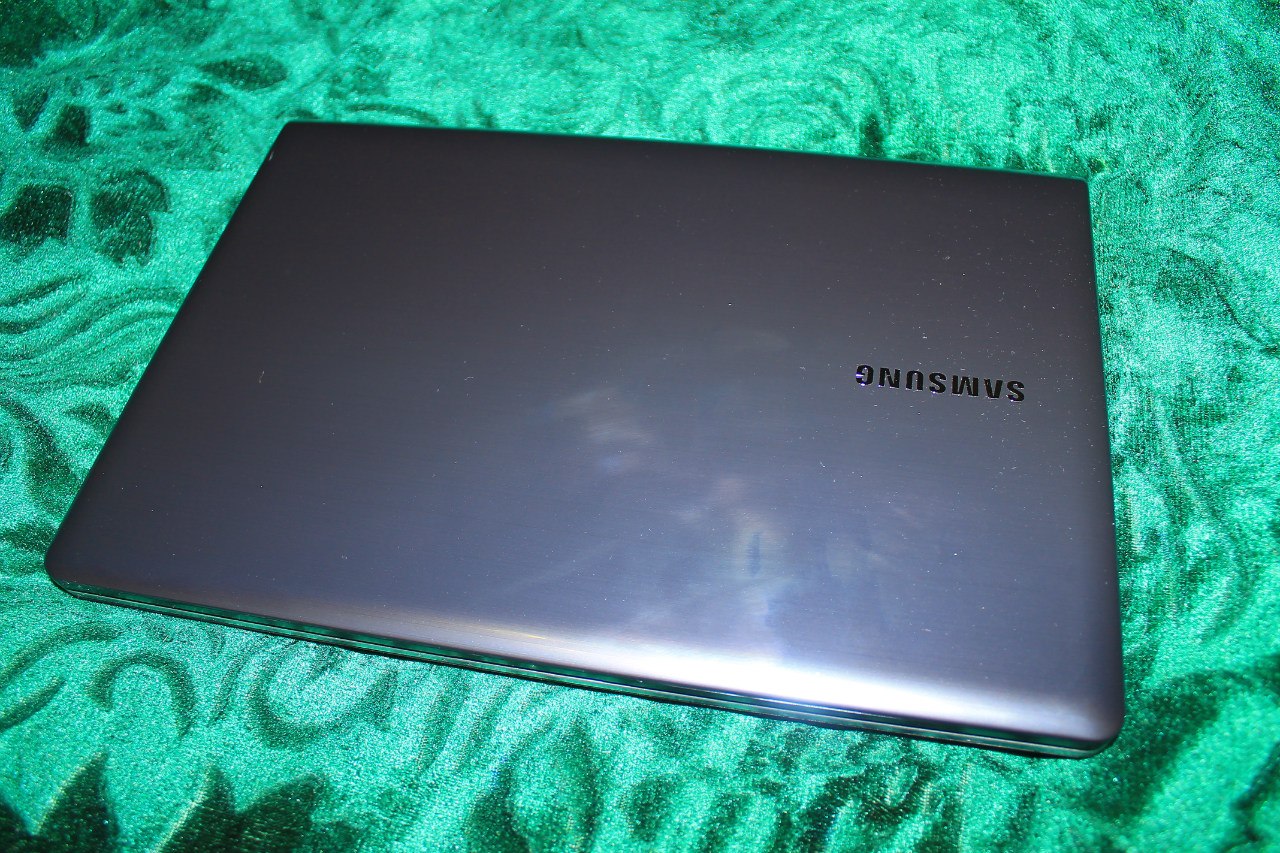
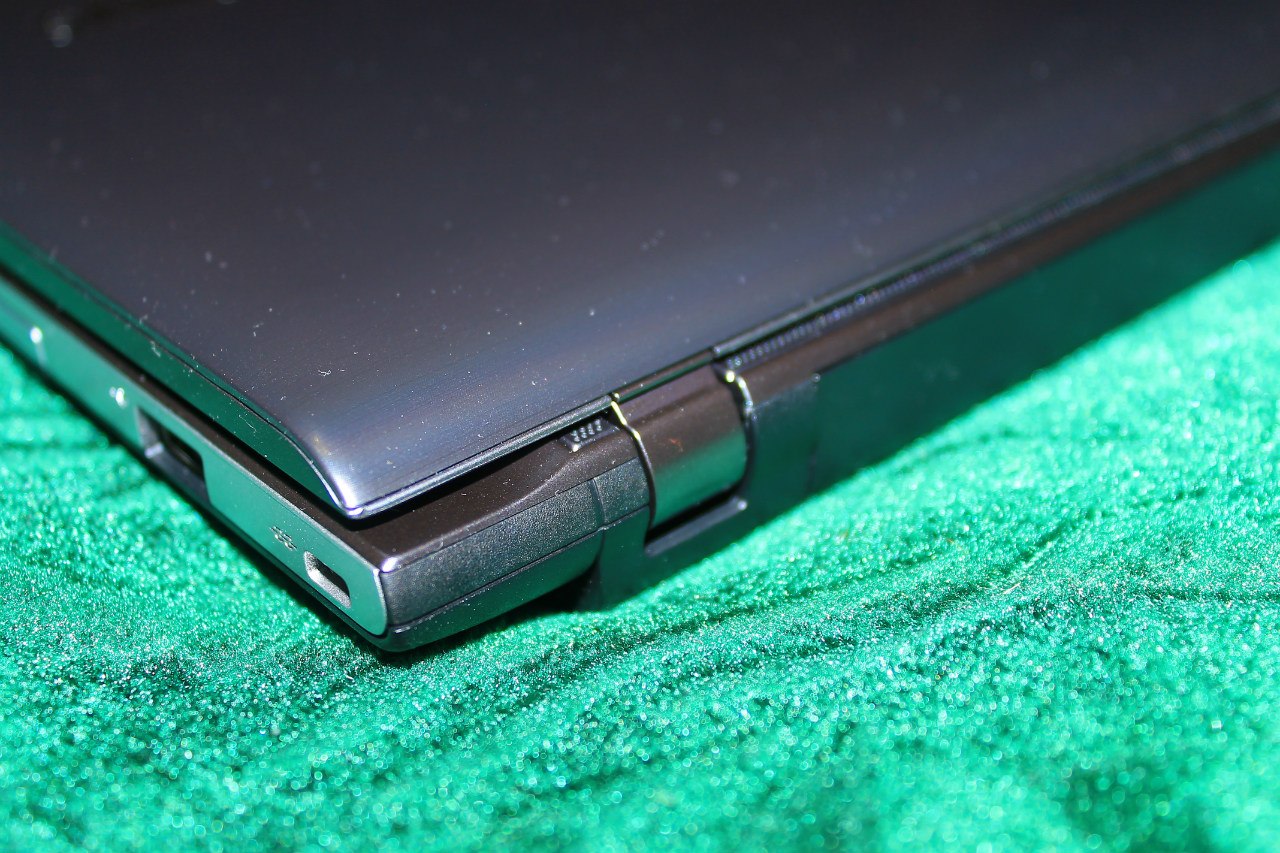
The hinges look solid enough. On the right is the headphone jack, microphone jack, DVD drive, USB-2.0 and Kensington lock.
(silver plastic and glare from the flash)


In front, we have indicators of HDD, Wi-fi, Charging, and activity. (it’s strange why the last 2 were not combined into 1 like on the N150 Plus) And an SD card slot.
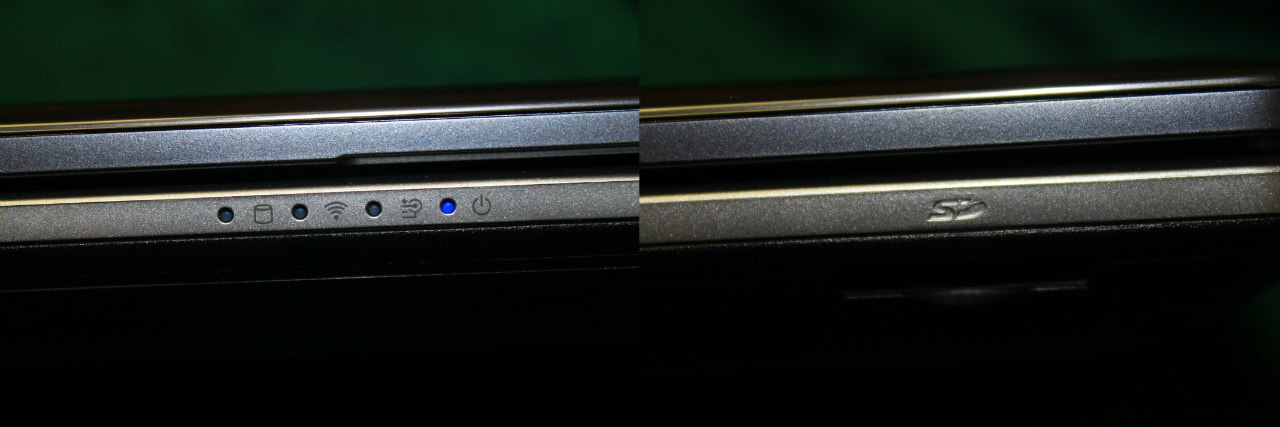
On the right is the charging connector, Ethernet 1000Mbit, VGA, HDMI and 2 USB 3.0.

At the back we have stickers with a Windows license, notebook marking and access to HDD, memory and WIFI (?). You can also see a 4400 mAh battery here.

By the way, the laptop is made of metal on top and has such iridescent stripes.


Inside the laptop near the touchpad is a ribbed surface that I saw on ASUS laptops.
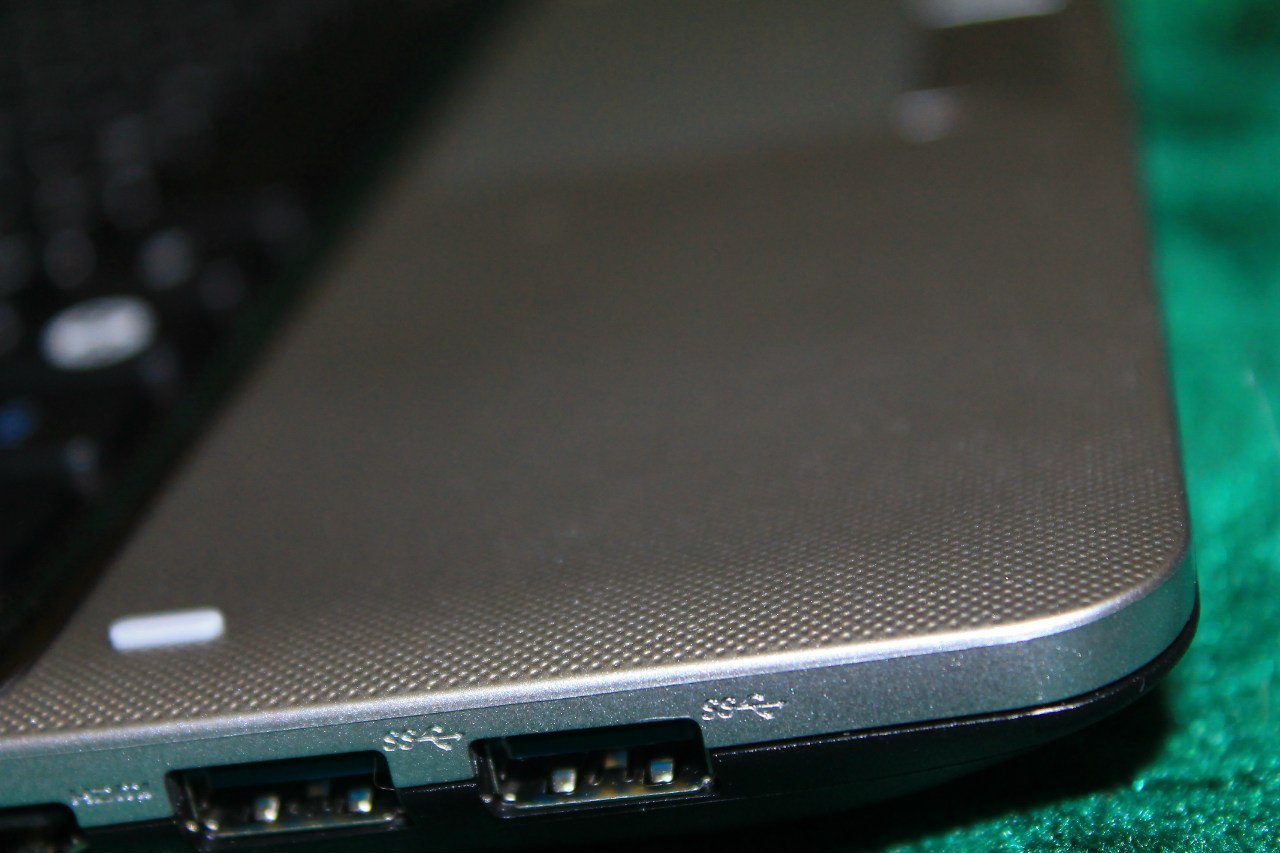
The touchpad itself is also silver, a little rough, the buttons are short, easy to press. By Linux, the touchpad refers to the touch of 3 fingers at the same time.
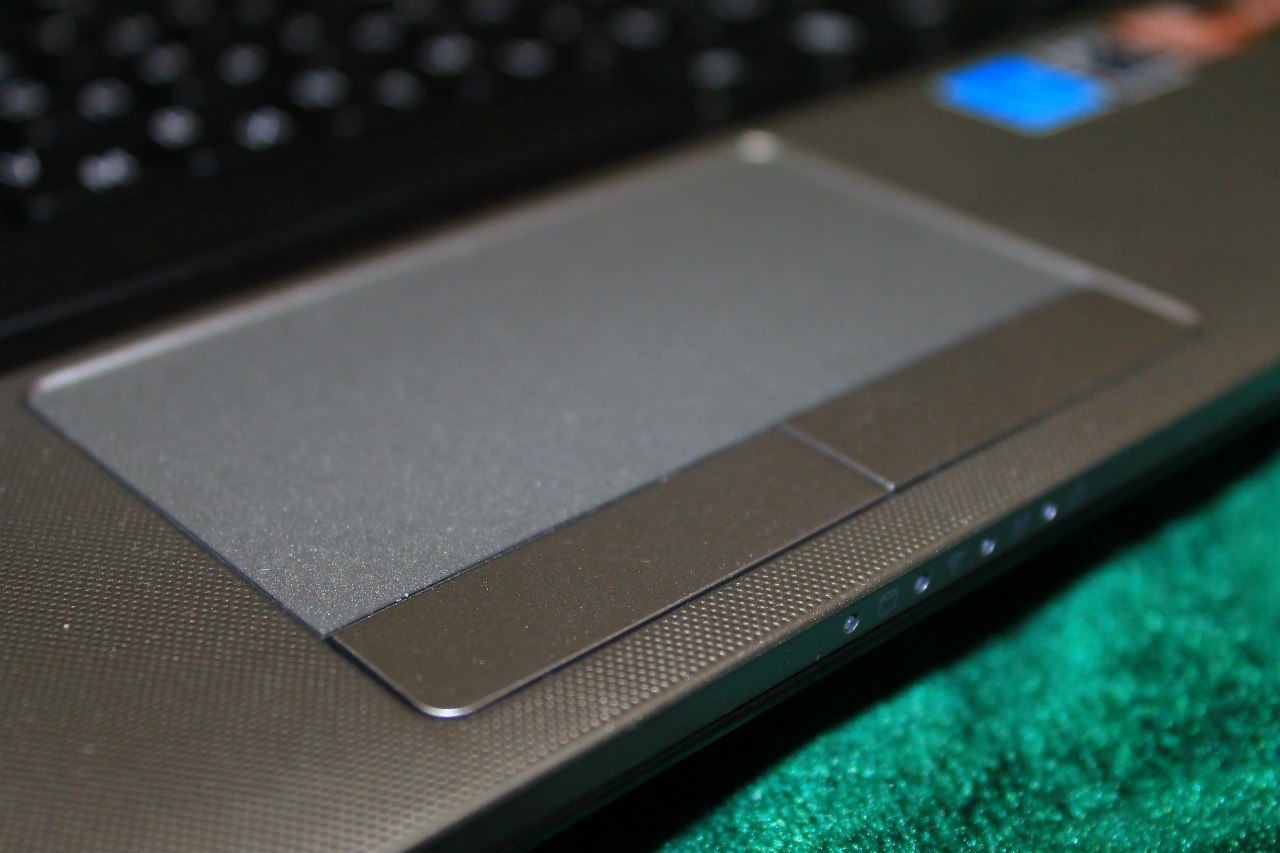
Keyboard island type. It’s a bit unusual to type, it’s very spacious. Pleased with the presence of Ctrl in the right place. (one of the main reasons why I take Samsung) The keyboard has Fn Lock, which allows you to use function keys without holding down the Fn button. I did not like the buttons on the right for navigation, very often I click them instead of Backspace.
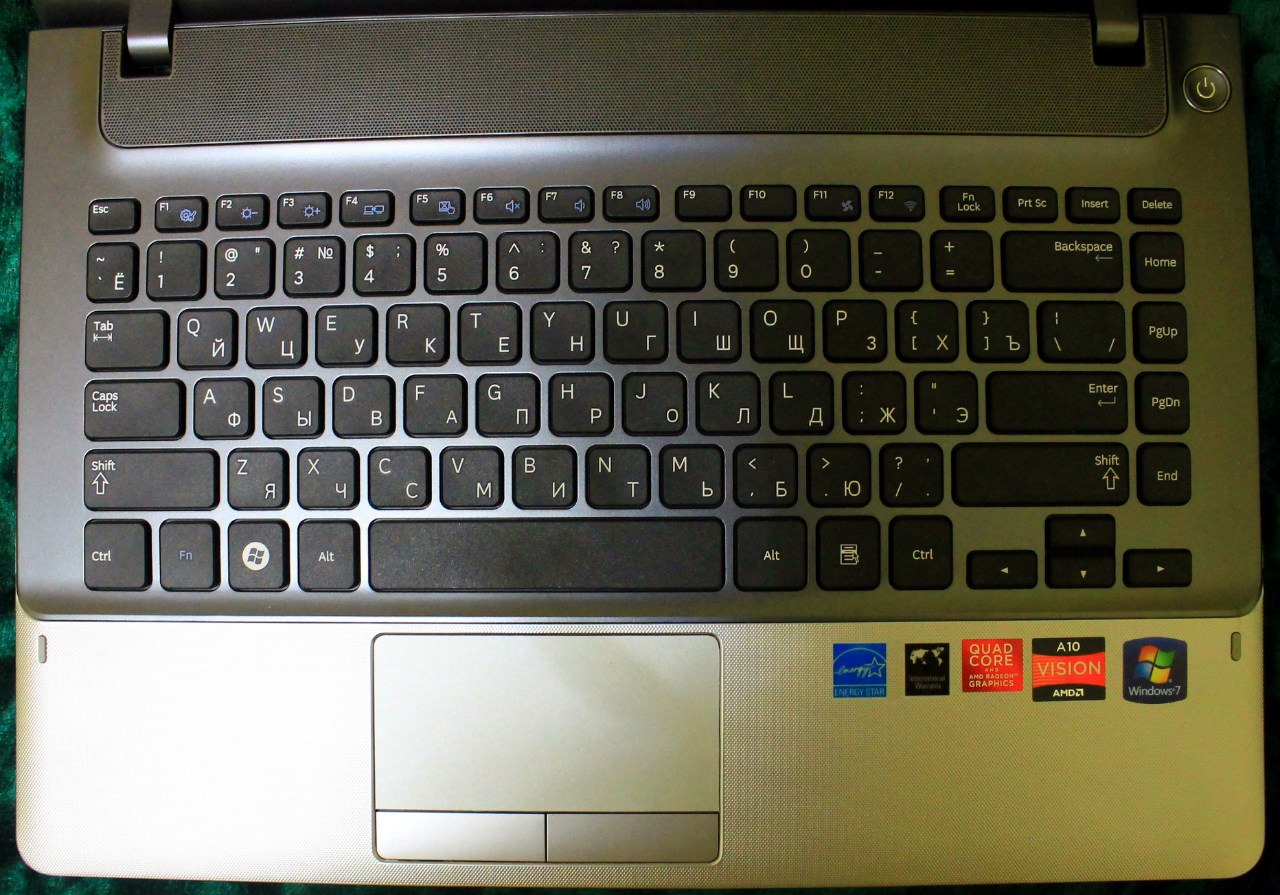
The arrows turned out to be surprisingly comfortable, up and down are not actually made in the form of a rocker as it might seem, but they also have no space between each other. However, this turned out to be a very convenient solution. Size does not seem small. You can even say that all the other keys are too large. Maybe this is after my netbook :)
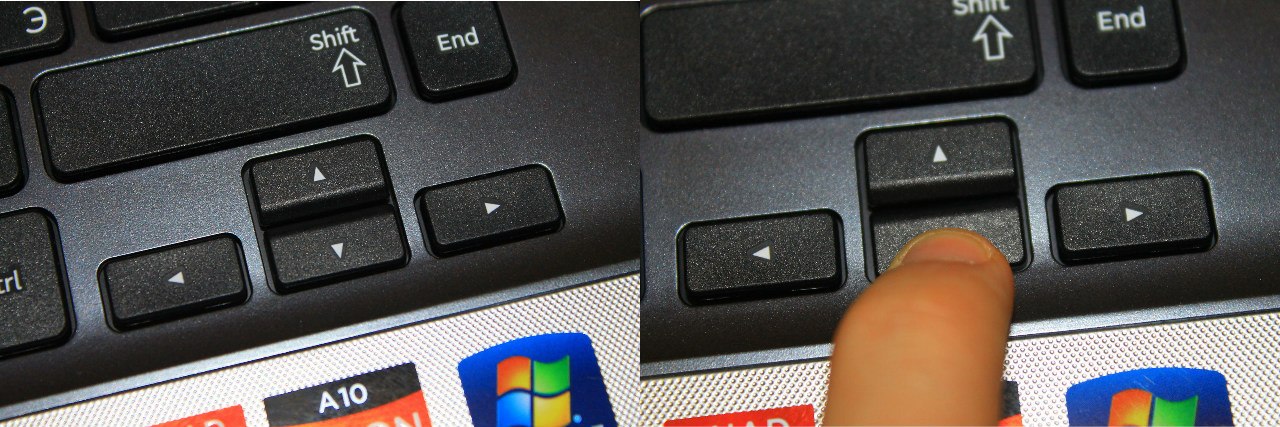
The camera and microphone are on top.
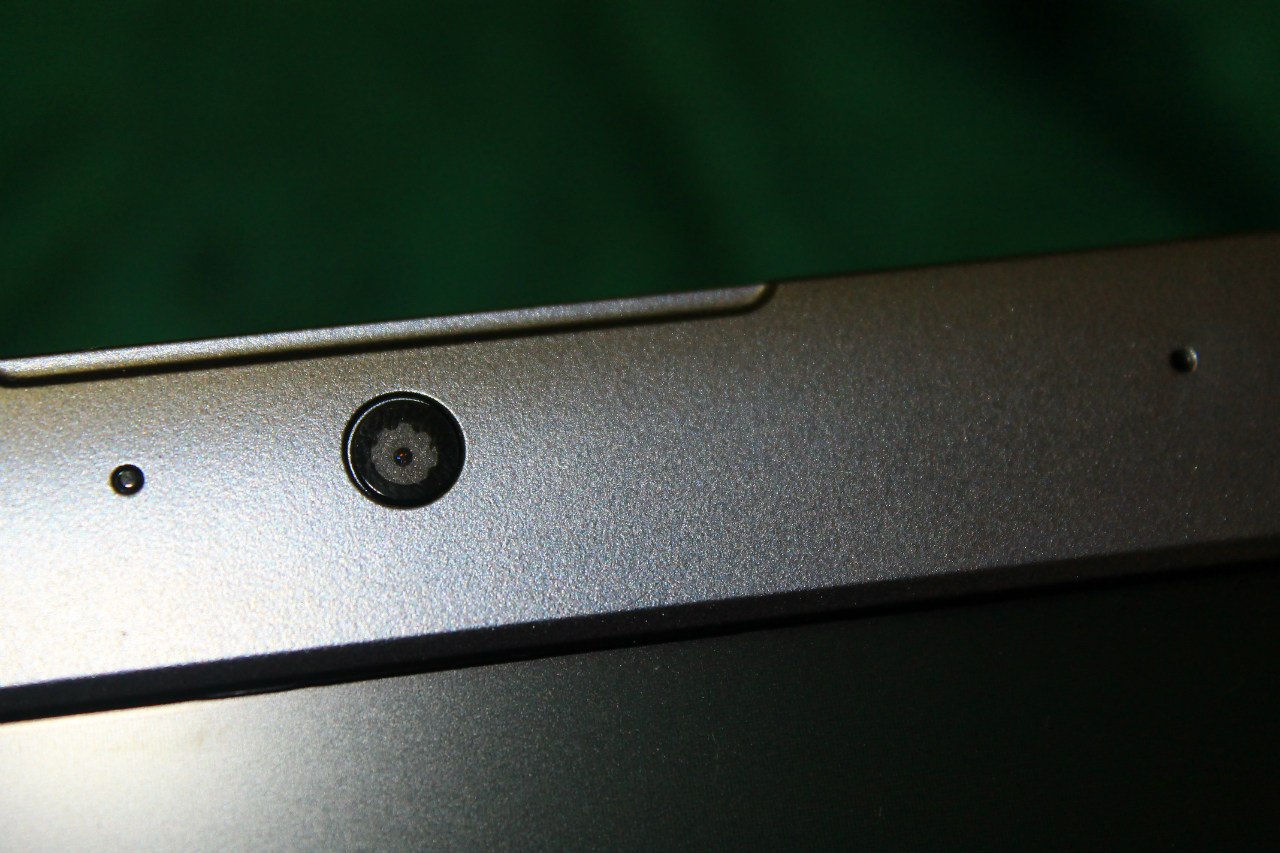
The power button glows in a pleasant blue color during operation.
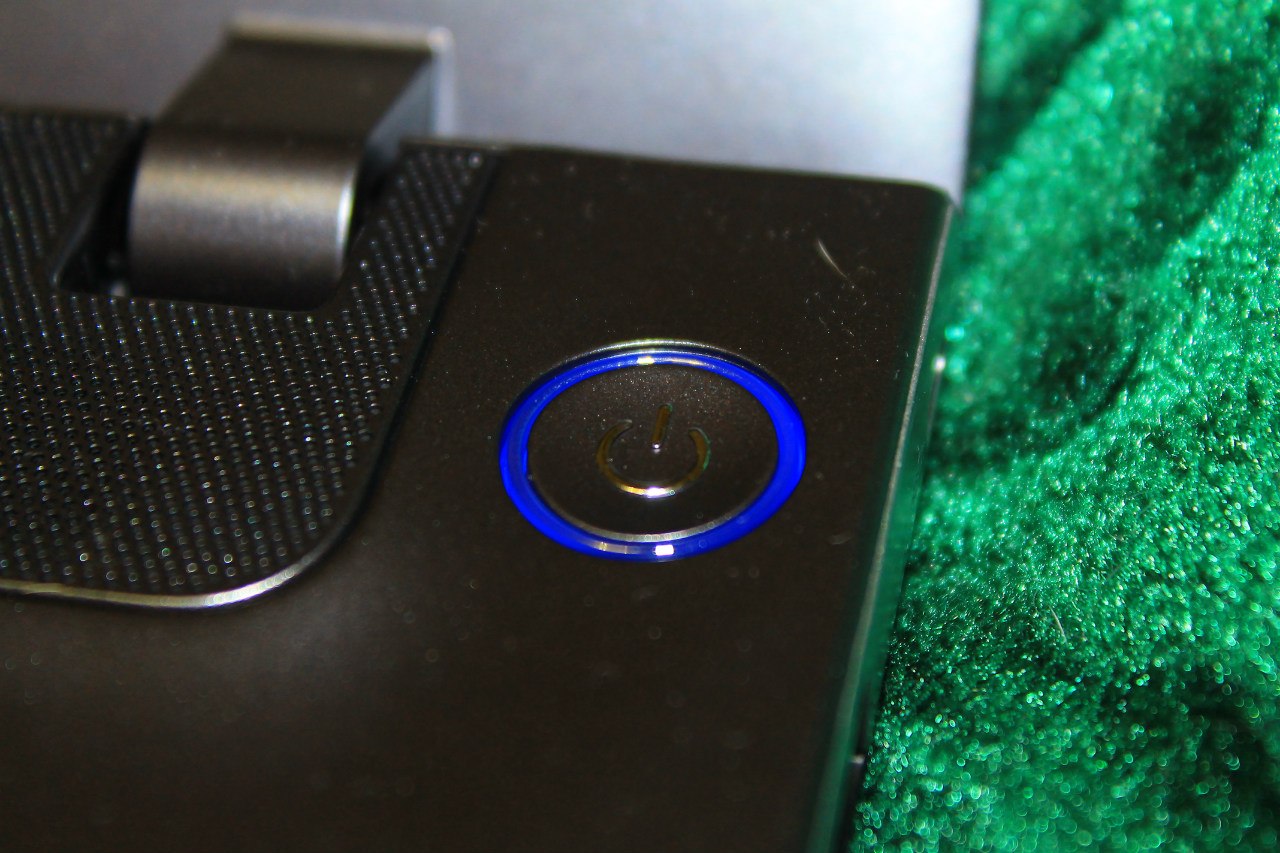
Linux usage
I installed from a flash drive and ran into a problem, after choosing a flash drive as the first device to start, loading from a flash drive did not occur.
You need to select the USB flash drive in Boot Priority-Hard disks, and then select Boot from ... in the last tab ... the name of your USB flash drive ... The
BIOS is very meager, there are absolutely no settings, either by port or by memory or overclocking. You cannot turn off one of the video cards or change the amount of allocated memory for the built-in memory. There is also a quick boot option. If it is selected, then the flash drive in Bios will not be detected. It is necessary to turn off this mode and reboot, however, a couple of times the quick boot option turned on by me.
After installation, almost everything worked. When you close the lid, the laptop falls asleep, when you open it wakes up. However, the sound disappears - it can certainly be cured. However, the console does not work at the same time, or rather framebuffer. Those. if you fall asleep in the framebuffer, the laptop will not wake up at all. As a treatment, ArchWiki offers vga = 0 as a download parameter, but then giant fonts are in the console. Perhaps a little later you will have to set it up.
You can switch between video cards in two commands. (with the Catalyst driver)
aticonfig --px-dgpu for faster snapshot or
aticonfig --px-igpu for weaker built-in
You can do this right before starting Xorg, because settings apply only after restarting Xorg.
An even bigger problem was that the laptop cannot fully switch to the external screen. More precisely, through VGA, he sees a maximum resolution of 1600x900. And you also need to reboot the Xs to see 1920x1080.
Playback through VAAPI works with a bang. 1080p video is spinning with a processor load of 1-4%!
Speaking of processor. There is such a thing
[root @ bupyc-notebook bupyc] # cpupower frequency-info
analyzing CPU 0:
driver: acpi-cpufreq
CPUs which run at the same hardware frequency: 0 1
CPUs which need to have their frequency coordinated by software: 0
maximum transition latency: 4.0 us.
hardware limits: 1.40 GHz - 2.30 GHz
available frequency steps: 2.30 GHz, 2.00 GHz, 1.80 GHz, 1.60 GHz, 1.40 GHz
available cpufreq governors: userspace, ondemand, performance
current policy: frequency should be within 1.40 GHz and 2.30 GHz.
The governor "ondemand" may decide which speed to use
within this range.
current CPU frequency is 1.40 GHz (asserted by call to hardware).
cpufreq stats: 2.30 GHz: 5.30%, 2.00 GHz: 0.09%, 1.80 GHz: 0.09%, 1.60 GHz: 0.13%, 1.40 GHz: 94.40% (27829)
boost state support:
Supported: yes
Active: yes
Boost States: 2
Total States: 8
Pstate-Pb0: 3200MHz (boost state)
Pstate-Pb1: 2700MHz (boost state)
Pstate-P0: 2300MHz
Pstate-P1: 2000MHz
Pstate-P2: 1800MHz
Pstate-P3: 1600MHz
Pstate-P4: 1400MHz
Pstate-P5: 900MHz
I rummaged through the entire Internet, I can not find how to enable boost state.
Also, under the arch, I can not adjust the brightness. However, after installing samsung-tools from the aura, it turned out to adjust the fan speed. Later I will add here a solution to brightness, boost state and solutions to the sleep problem if I find it.
Games, multimedia, temperature.
As I promised, I tested the games on Windows. By the way, if after installing Linux, Windows does not boot, you can safely choose recovery after boot bootloader'a Windows. He didn’t erase Grub2 from me, but simply restored the Windows to working. By the way, I started it like this:
1. pressed the C button in the Grub2 menu
2. set root = (hd0, msdos1)
3. chainloader +1
4. boot
You will have 2 points: restoring Windows and starting it.
Let's move on to the games.
During the game in Left4Dead2, at first everything was terribly slow at high and I played at medium - the laptop was quiet and barely warm. And then it dawned on me that I had accidentally turned on silent mode! In it, the game showed 30 fps at medium, as I understand it, only the integrated + reduced processor frequency worked here.
However, after turning off the silent mode, even at the maximum settings of all parameters, smoothing and filtering, the game shows 60 FPS, which is actually logical considering the included vertical synchronization. In this mode, the laptop warmed up a little more, but this did not cause any inconvenience. That is, the temperature was at a normal level.
To find out the exact temperature and warm up the processor, I downloaded AIDA64 Trial.
During the stress test, the video driver crashed. And then Windows also fell ... but found out that chrome keeps the text in the fields even after the fall.
I played for about 30 minutes, the temperature is not more than 70 degrees for both the CPU and the GPU. The cooling works well, but even at maximum speed it does not sound very loud. During the game, the sound of the fans is imperceptible at all. The speakers are under the screen, as for me it is very loud (at the maximum even my ears hurt, so I think that's enough for everyone), and the sound is high-quality and surround. At maximum volume does not fonit.
I already said about VAAPI in the iron section, but I want to add that in Linux, the xvba-video package is required to work with AMD Radeon HD. In VLC, you will need to specify acceleration via the GPU in the settings, and mplayer needs the mplayer-vaapi package to work. You will need to start with the option -vo vaapi: gl -va vaapi -vsync. You can also use gnome-mplayer. It's already to your taste.
All popular formats are accelerated, but if something does not work with acceleration, there will not be any special problems. The 13GB 1080p movie this laptop pulls with a load of 40-80%. The same film with acceleration as I wrote 0-5% no more.
Also, this processor can AMD Stream. On it you can convert video using the GPU, which gives a significant performance boost. However, under Linux this feature is not yet available.
Conclusion
Nice laptop with balanced hardware.
+ fast processor
+ good price (I bought for 16,950 rubles)
+ fast integrated card especially compared to the HD4000 :) and fast discrete + the ability to simultaneously work under Windows.
+ a comfortable keyboard and touchpad
+ FN in the left corner
+ a 750Gb hard drive (competitors often have 500Gb for that price)
+ 6Gb of RAM
+ a
matte screen - Home, End buttons, etc. on right.
-Some problems with ACPI and laptop power saving
-Battery for only 4 hours. Without power saving in the current mode it is 1-2 hours. At maximum brightness.
-Heavy
The article will be supplemented over time. There is little information on the internet on this laptop. I did not see reviews on him at all. If someone is interested in how they play games under Windows, here’s the channel of a person on YouTube who shoots games on this laptop. www.youtube.com/user/BornInTheHell?feature=g-high-u A
couple of videos.
All games he has on medium or high settings.
